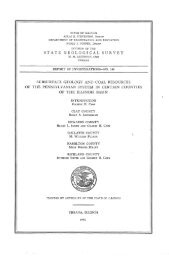Edited by James E. Palmer and Russell R. Dutcher - University of ...
Edited by James E. Palmer and Russell R. Dutcher - University of ...
Edited by James E. Palmer and Russell R. Dutcher - University of ...
You also want an ePaper? Increase the reach of your titles
YUMPU automatically turns print PDFs into web optimized ePapers that Google loves.
een caused <strong>by</strong> alternating humid <strong>and</strong> arid clinaates.e containing whitetau At some localitiesin western Kentucky <strong>and</strong> southern Indiana, basalPennsylvanian strata consist almost entirely <strong>of</strong> whitequartz pebbles in a ferruginous f ine-grained s<strong>and</strong>stonematrix. The abundance <strong>of</strong> white quartz pebbles withinbasal Pennsylvanian s<strong>and</strong>stone will be observed at severallocalities in the basin. The depositional history <strong>of</strong>the s<strong>and</strong>stone <strong>and</strong> its similarity to the Millstone Grit <strong>of</strong>Engl<strong>and</strong> will be considered.e gradual increase ike argillaceousflakes with decreasing age <strong>of</strong> ciastig: rocks. This increasesuggests a gradual change in provenance <strong>of</strong> sediments inmiddle <strong>and</strong> late Pennsylvanian time. Evidences <strong>of</strong> sucha change will be considered at several field trip stops.limestone members as much as 50 feet thick have beenrecognized. Coal, one <strong>of</strong> the least abundant tiahic units<strong>of</strong> the Pennsylvanian System, constitutes no more thantwo percent <strong>of</strong> rock strata in most areas.More than 500 units sf s<strong>and</strong>stone, si6tstone, shale,limestone, coal, <strong>and</strong> clay are distinguishable in thePennsylvanian strata <strong>of</strong> the liiirnoisness <strong>and</strong> great number <strong>of</strong> vertical cindicate that changes in depositioria! environment wereecause <strong>of</strong> the relativefy large number oh lithicsomewhat complex stratigraphic nomenclaturehas developed (figs, 1 <strong>and</strong> 2), Although some cornmonalityin nomenclatures exists between Illinois,Indiana, <strong>and</strong> Kentucky, many different names havealso been adopted ii-1 each state, ML~c~ hasto establish equivalance <strong>of</strong> stratigraphic nomenciaturein each state.balls occur in 17 coals aPliinois Basin Coal Field. An opportunity will be affordedat one or more stops on the field trip to obtaincoal ball samples.ennsylvanian stratiPennsylvanian rocks have a maximum thickness <strong>of</strong>m) in Union County,western Kentucky, where the thickest section occurs inaben block downthrown more than 1,QOm). Douglass (this Guidebook, part 2) hasfied Permian (Wolfcampian) strata in the uppermostpart <strong>of</strong> the graben block. Elsewhere in the lllinoisBasin, the maximum thickness <strong>of</strong> the PennsylvanianSystem is slightly more than 2,s 8 feet (762 m). Theformations are generail y thickest in southeastern P llinois<strong>and</strong> western Kentucky. Some lower strata arepresent only in the southern part <strong>of</strong> the basin <strong>and</strong> areoverlapped <strong>by</strong> younger formations in the north.About 90 to 95 percent <strong>of</strong> the PennsylvanianSystem in the lllinois Basin consists <strong>of</strong> elastic rocks(figure 2, Peppers <strong>and</strong> Popp, this u idebook, part 2).Siltstone, shale, <strong>and</strong> underclay nstitute about 40percent <strong>of</strong> the lower part <strong>of</strong> the system <strong>and</strong> 65 to 70percent <strong>of</strong> the middle <strong>and</strong> upper parts.particularly well developed in the lowthey constitute about 6 percent <strong>of</strong> strata; in the middle<strong>and</strong> upper parts, they constitute only about 25percent <strong>of</strong> the strata. Limestone is rare, but in someareas constitutes as much as 5 to 10 percent <strong>of</strong> theupper two-thirds <strong>of</strong> the system. Limestone is especiallycommon in the Bond Formation <strong>of</strong> lillinois, whereennsylvanian Systert? in the illinsisasin were deposited in a subsiding trsrsgh open at itssouthern margin <strong>and</strong> batuplifts to the north, east,times, bordering structural features were at or belowdepositional base level, <strong>and</strong> some lithic emits were depositedwithout substantial interruption in an areaextending from Pennsylvania to Kansas (Wanless, 1935,Part 8, p. 72). The lllinois Basira was strMany major structurai features <strong>of</strong> the Biiinois Basinoriginated or experienced important growtlr <strong>and</strong> developmentduring the Pennsylvanian Period. "The La SalkAnticlinai Belt (fig. 1, which extends from 1-a SalkCounty in northern Illinois to Lawrencesoutheastern Bilirrcsis, a distance <strong>of</strong> more tha(320 km), was substantialiy uplifted prior to deposition<strong>of</strong> Pennsylvanian rocks. Much <strong>of</strong> the area <strong>of</strong> theLa Salle An.ticlinai Belt must have been a penirlsula orarchipelago during early ennsyivanian time, becauseno Caseyvilie strata vvere deposited, <strong>and</strong> .the Abbott<strong>and</strong> Spoon Formations are rnhach thinner there thanelsewhere. CIegged that progressivemovement took plPe13r1sylvanian time,<strong>and</strong> intensive upliftanian strata occurredlvanian or post-Penrisylvanian time.Monocl ine arm' associated Sakmines (fig. 3) extend along the westernmargin <strong>of</strong> the Fairfield(160 km). The monocline farms a hinge line separatinggently dipping strata to the west from more steeplydipping rocks at the margin <strong>of</strong> -the Fairfieldmonodine has iocal structural relief sf abo(I52 m) at the Herrin (No. 6) Coal <strong>and</strong> more thanINTRODUCTION
















